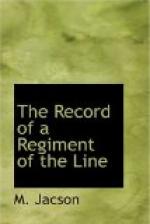The mounted troops and guns were very slow in coming out, with the result that a large quantity of cattle located in the various kloofs which should have been captured, escaped. Abel Erasmus was taken the following day.
The force bivouacked at Kruger’s Post for the night, and returned to Lydenburg next day, bringing with it fifteen Boer families in addition to the prisoners. On their return a wire was received by Colonel Park from Lord Kitchener: “Highly appreciate successful operation of Colonel Park and troops engaged.”
The remainder of the month was spent mostly in convoy work between Witklip and Lydenburg. Whilst returning to Lydenburg with one of these convoys, General Walter Kitchener, who was riding ahead with a small escort, suddenly came across some Boers lying concealed in the grass. He lost two of his own personal escort killed, his own horse also being shot. He himself narrowly escaped capture.
On April 10th an order was issued for the battalion to concentrate in Lydenburg, preparatory to a general advance of three columns. The posts at Bridge Hill, Mission Village, Strathcona, and Paardeplaats were evacuated, and the company at Witklip withdrawn.
The destinations of the columns were as follows:—
One column under Colonel Park was to proceed in the Kruger’s Post direction and to scour the country towards the north, and later to join hands with General Kitchener’s column, which was to proceed in a north-westerly direction, and the third column under Colonel Douglas was to proceed from Witklip in a westerly direction.
On the 12th, Lieutenant-Colonel Park handed over the command of the battalion to Major Davies, who had arrived from Witklip, and Captain Jacson took over the duties of second in command.
CHAPTER V
TREKKING IN THE NORTH-EAST TRANSVAAL
On April 13th, 1901, General Walter Kitchener commenced his long trek with a night march.
His force consisted of—
Two guns 53rd F.B.R.A. under Major Johnson and Captain
Talbot-Ponsonby.
One 5-inch gun.
One 5-inch howitzer.
One naval 12-pounder.
One company mounted infantry.
1st Battalion Devonshire Regiment (20 officers and
900 men).
2nd Battalion Rifle Brigade.
The 6th Western Australians.
General Walter Kitchener’s column formed one of the many operating at the time in a combined movement in the Northern Transvaal and bush veldt, under the direction of General Sir Bindon Blood.
Two columns were sent north to drive the bush veldt, forcing any Boers that might be located there on to the other columns, who were acting as stops near the Tautes Berg and Bothas Berg, immediately north of the Pretoria-Lorenzo railway line.
General Walter Kitchener decided to start his operations with an attack on Schoeman’s laager, and for this purpose the Regiment was ordered to take up a position before dawn which would cut off the laager, situated in the Steenkampsberg mountains, near the entrance of the Lydenburg road into the hills, from the north. This entailed a night march of about sixteen miles. The remainder of the column was to proceed by the main road and attack the laager at daybreak.




